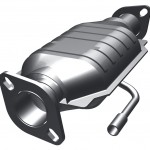Volumetric efficiency is used to describe the amount of fuel/air in the cylinder in relation to regular atmospheric air.
If the cylinder is filled with fuel/air at atmospheric pressure, then the engine is said to have 100% volumetric efficiency. On the other hand, super chargers and turbo chargers increase the pressure entering the cylinder, giving the engine a volumetric efficiency greater than 100%.
However, if the cylinder is pulling in a vacuum, then the engine has less than 100% volumetric efficiency.
Normally aspirated engines typically run anywhere between 80% and 100% VE.
So now, when you read that a certain manifold and cam combination tested out to have a 95% VE, you will know that the higher the number, the more power the engine can produce.
Characteristics of a rotary engine compared to a 4 stroke piston engine:
A rotary engine’s rotor completes one stroke for every 270º of crank rotation:
- Intake 270º of crank rotation.
- Compression 540º of crank rotation.
- Combustion 810º of crank rotation.
- Exhaust 1080º of crank rotation.
In other words, it takes a rotary engine 1080º of crankshaft rotation to complete an intake, compression, combustion & exhaust cycle. Or 3 crankshaft rotations per cycle.
A piston completes one stroke every 180º of crank rotation:
- Intake 180º of crank rotation.
- Compression 360º of crank rotation.
- Combustion 540º of crank rotation.
- Exhaust 720º of crank rotation.
A piston engine requires 720º of crankshaft rotation to complete a cycle. In other words, 2 complete revolutions of the crankshaft.
A rotor rotates @ 1/3 of the rate of the crankshaft. In other words, for every 1 revolution of a rotor, the crankshaft has done 3 revolutions. For example when the tachometer on a vehicle indicates 9000rpms, one rotor is turning at 3000rpms.
On two rotor engines, the front & rear rotors are offset 180º from each other. A rotation of 360º of the crankshaft will bring the 2 rotors through the combustion stroke. Since each combustion chamber is -in the case of a 13B- 654cc, every 360º of crankshaft rotation will displace a total of 1308cc.
In order to interpolate the cycles and volume displaced by a rotary engine vs. a 4 piston engine, we can use the following logic:
- A piston engine takes 720º of crank rotation to complete a cycle.
- In a rotary engine, 720º will produce 4 combustion strokes:
- 360º of crank rotation => 2 combustion strokes.
- 720º = 360º x 2
- 720º of crank rotation => 4 combustion strokes.
- 4 strokes = 654cc x 4
- 4 strokes = 2616cc
For simplicity reasons, we can stipulate that a 1.3L, two rotor rotary engine is similar to a 2.6L 4 piston, 4 stroke piston engine. It may not be academically correct, but it is a relatively simple way of visualizing how the rest of this write up and the formulas that are normally applied to piston engines can be applied to a rotary engine.
Furthermore, applying the same calculations utilized to determine Volumetric Efficiency (VE) on a piston engine, but for a rotary engine will yield optimistic results. If we were to consider the rotary engine, a 4 stroke engine with a displacement of 1.3L, the results would render a VE of over 100% in more than one instance, which is very unrealistic.
Did I make any sense? Mmm maybe not but, try to follow the next steps as I try to make sense out of what I have gathered so far.
A little experiment…
Well, today I finally gave up and decided to do a little experiment that I found while searching for an effective method to calculate Volumetric Efficiency on a vehicle without having to yank the engine from the car. I came across the following experiment: Calculating your cars volumetric efficiency
I will assume that you are either too lazy or tired to follow the link, so I will explain a bit on what does the experiment entail.
The experience requires the following: (1)vehicle with an engine; (1)OBD-II Scan Tool; (1)stock air intake with a Mass Air Flow sensor (MAF) in stock trim -according to the author, a slight variance from factory stock, such as removing the screen or repositioning the sensor will give the experiment little value- (1)stretch of private, safe, deserted road.
Once you’ve acquired all those items the procedure is rather painless. Attach the scan tool to the vehicle and make sure it can report the following things: Engine RPM, Intake Air Temperature & Air Flow. Using the deserted stretch of private road, run the vehicle from a low engine rpm (2500rpm) @ WOT to redline (or as far as you want your sample to go..) while recording Intake Air Temperature (IAT), Engine Speed (RPM) & Intake Mass Air Flow (IMAF).
Once you have your data logged, re-read the experiment from the link provided and start crunching numbers! Its principle seems straight forward: based on the calculated theoretical volumetric air flow for your engine (a Renesis in this case), and the data you logged, you can approximate the actual VE of your particular engine. I will provide the formulas I used at the end of this article.
Theoretical Volumetric Air Flow was calculated assuming that a 13B MSP rotary engine has similar displacement in 720º of crankshaft rotation as a 2.6 Liter, 4 stroke piston engine.
Notice how VE climbs as Engine Speed increases, until it reaches 5500rpms. This is were the engine is rated to produce peak torque, therefore its safe to assume that VE will peak at or nearby 5500rpms. Furthermore, you can safely assume that Volumetric Efficiency plotted against engine speed will mimic the shape and characteristics of the torque curve produced by the engine.
Note that the plotted VE is somewhat linear: starts @ 80% and climbs its way to a tad over 100%. If this experiment’s results could be validated and the parameters I used were accurate, it would signify that the Renesis engine -on my car at least- is in fact very efficient for a normally aspirated internal combustion powerplant -VE definition above.
Calculating Volumetric Efficiency (VE) for the Renesis (13B MSP) rotary engine:
We will use the following values obtained during our data log:
Data:
Intake Air Temperature (IAT) = 82ºF
Engine Speed (RPM) = 8561rpm
AirFlow (MAF) = 27.3lb/minute
THEORETICAL AIRFLOW CALCULATION:
Formula:
[(ED) x (rpm) x (VE)] / [(ES) x (C)] = TAF
Variables:
ED = Engine Displacement [in³]
rpm = Engine Speed [RPMs]
VE = Volumetric Efficiency [%]
ES = Engine Stroke Coefficient [#]
C = Conversion coefficient from in³ to ft³
TAF = Theoretical Air Flow [ft³]
Solving:
[(159.64in³) x (8561rpm) x (1)] / [(2) x (1728 in³/ft³)] = TAF
TAF = 395.42ft³
Values:
ED = 2.6 Liters (1308cc x 2) >> 159.64in³
rpm = I chose 8561rpm arbitrarily.
VE = Since this corresponds to Theoretical VE, we assume VE = 100% (1)
ES = Since we simplify a 13B engine to a 4 stroke piston engine -thus 2.6L- we use a coefficient of 2.
C = 1728in³/ft³
AIR DENSITY & TEMPERATURE CALCULATION:
Formula:
[(t1) / (t2)] = [(d2) / (d1)]
Variables:
t1 = Temperature of air for a known density [ºR]
t2 = Temperature of the intake air measured by the IAT sensor [ºR]
d1 = Density of air for a known temperature [lb/ft³]
d2 = Density of the intake air [lb/ft³]
Solving for [d2]:
[(t1) / (t2)] x (d1) = (d2)
[(491.67ºR) / (541.67ºR)] x (0.0808lb/ft³) = d2
d2 = 0.073341lb/ft³
Values:
t1 = 32ºF >> 491.67ºR
t2 = 82ºF >> 541.67ºR
d1 = 0.0808lb/ft³
VOLUMETRIC FLOW RATE CALCULATION:
Formula:
[(MF) / (d2)] = AVF
Variables:
MF = Mass Flow rate taken from CANScan [lb/minute]
d2 = Density of the intake air [lb/ft³]
AVF = Actual Volumetric Flowrate [ft³/minute]
Solving:
[(27.3lb/minute) / (0.073341lb/ft³)] = AVF
AVF = 372.233ft³/minute
Values:
MF = 27.3lb/minute
d2 = 0.073341lb/ft³
VOLUMETRIC EFFICIENCY CALCULATION:
Formula:
[(AVF) / (TAF)] = VE
Variables:
AVF = Actual Volumetric Flow rate [ft³/minute]
TAF = Theoretical Air Flow rate [ft³/minute]
VE = Volumetric Efficiency [%]
Solving:
[(372.233ft³/minute) / (395.42ft³/minute)] = AVF
AVF = 0.94 >> 94%
Values:
AVF = 372.233ft³/minute
TAF = 395.42ft³/minute
Is this remotely close to accurate? I truly don’t know! I simply took the time to do a little research through different channels & gathered information. If you have any comments, or would like to make any suggestions or correct aything, please by all means, contact me!






any chance of plotting this out ?